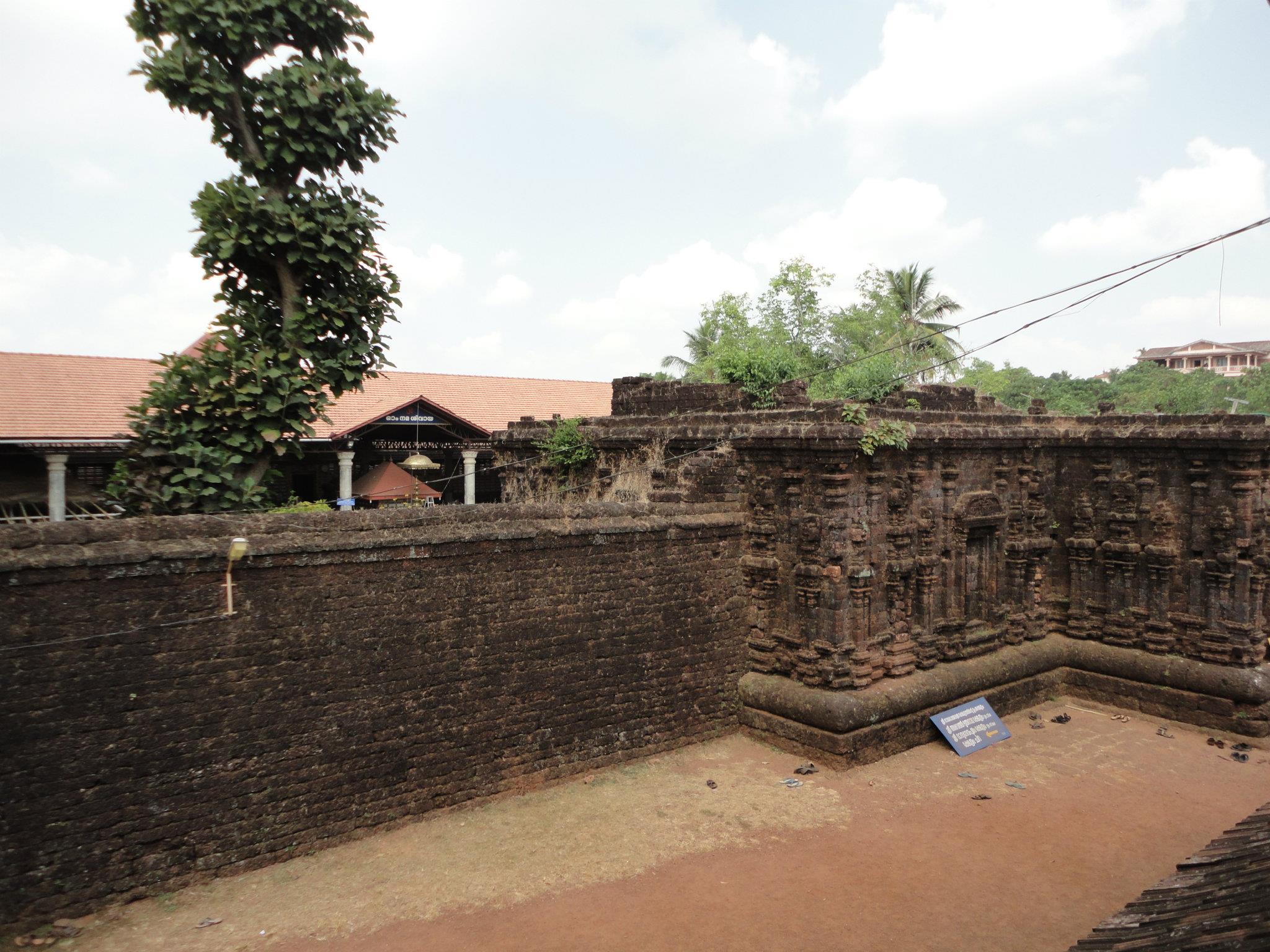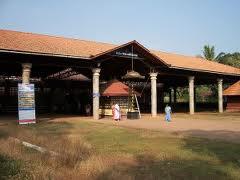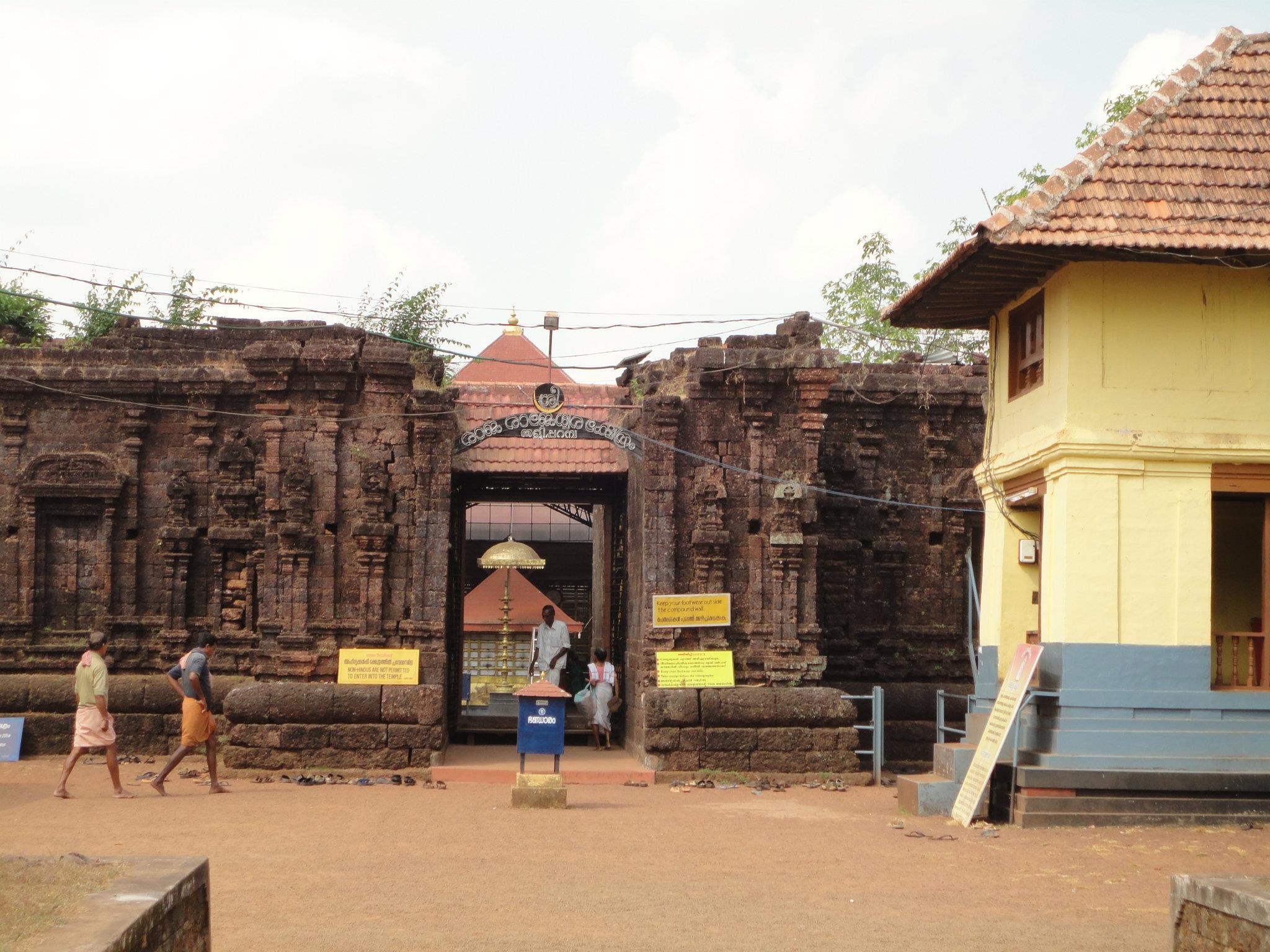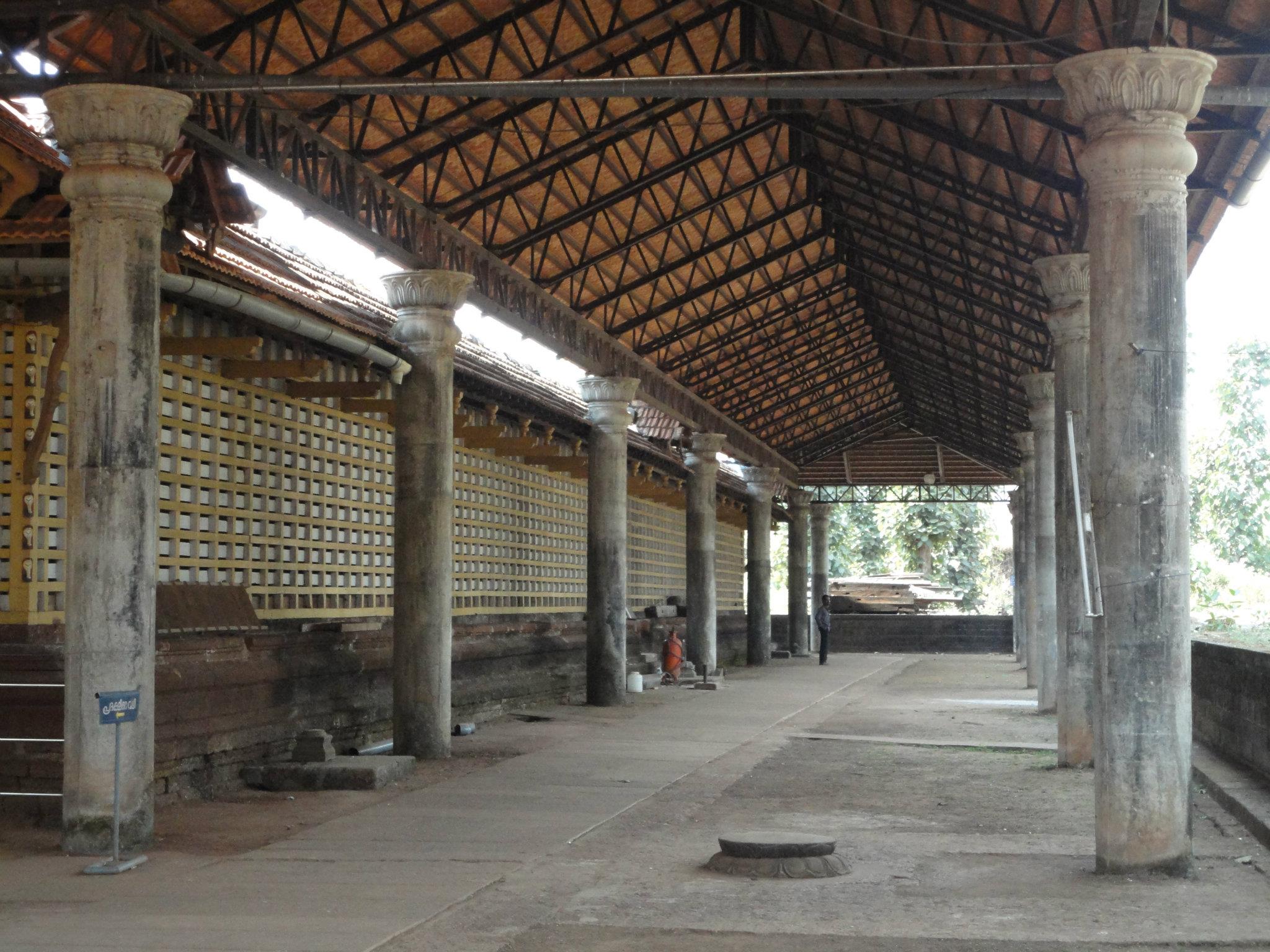Rajarajeshwara Temple is a revered Hindu temple located in Taliparamba, in the Kannur district of Kerala, India. It is dedicated to Lord Shiva and is considered one of the 108 sacred Shiva temples of Kerala.
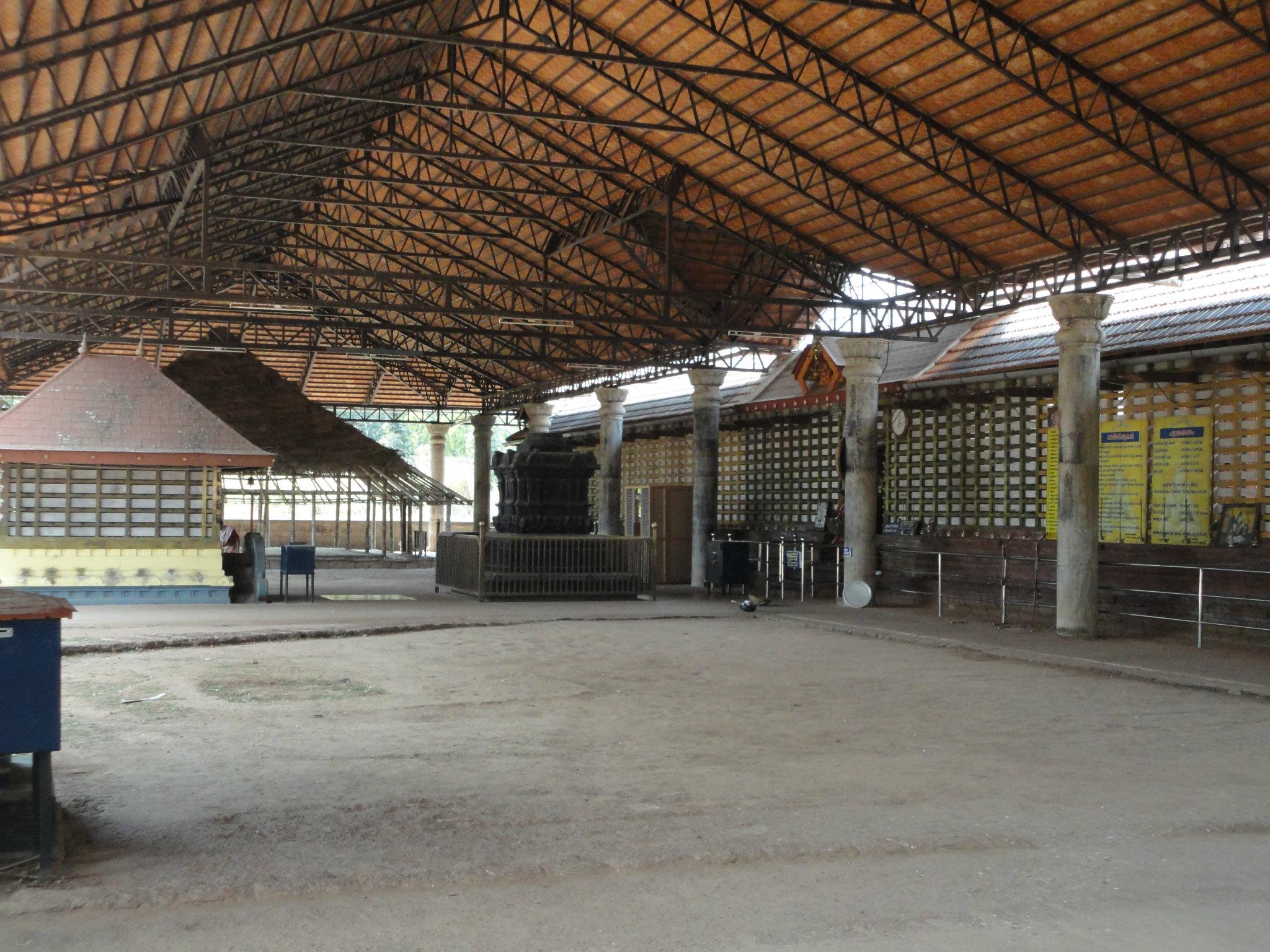
At the Rajarajeshwara Temple, Lord Shiva is revered in his majestic form, seated atop Nandi, the sacred bull. His feet rest on Kumbhodara, a Shiva Gana with a lion's face. Nandi is surrounded by the Ashta Bhairavas and prominent Shiva Ganas, including Analodbhava, Nikumbha, Herambha, and others, who serve as Shiva's divine attendants.
Shiva is depicted along with Shakti (Parvati) and their children—Veerabhadra and Bhadrakali—both believed to have emerged from Shiva’s own divine energy. He is portrayed holding a damaru (drum) attached to a trishula (trident), with his body covered in sacred ash and a bluish hue around his neck. His matted hair, adorned with the crescent moon, also carries the goddess Ganga. He wears a tiger skin as a lower garment, a belt with bells, and a garland of rudraksha beads. The serpent Vasuki, king of the Nagas, coils around his neck, and a third eye is prominently shown on his forehead. Several Nagas are worn as ornaments.
The Rajarajeshwara Temple beautifully depicts Lord Shiva surrounded by devotees, the Shiva Ganas, chanting the Panchakshari mantra. The temple showcases Shiva with his consort Shakti and sons Ganesha and Subrahmanya, symbolizing divine completeness. Dedicated to Shiva as Rajarajeshwara or Aishwarya Prabhu, the temple uniquely blends Shaiva and Vaishnava traditions, with Goddess Mahalakshmi believed to reside at the eastern entrance, reflecting the area's historical connection as Lakshmi Puram.
Next to the main temple stands a smaller shrine dedicated to Kumbhodara, also known as Bhootha Natha. Kumbhodara is a lion-faced, pot-bellied leader among Shiva’s Gaṇas, renowned for his insatiable appetite and his role in disciplining the rest of the Shiva Ganas.
The temple complex, spread across eight acres, is enclosed by a massive perimeter wall constructed using finely cut laterite stones, fit together without mortar using advanced ancient masonry techniques. The wall includes two traditional gopurams (gateway towers)—one facing east and the other west. The wall itself is trapezoidal, about 4 meters wide at the base and narrowing to 2 meters at the top. As per custom, the main entrance is on the eastern side.
Upon entering through the eastern gate, devotees begin a clockwise circumambulation (pradakshina) of the central shrine. To the north lies a small shrine housing a benevolent Yakshi, a guardian spirit carved from wood, shown holding a mirror. Unlike the fearsome Yakshis of local folklore, this deity is believed to grant prosperity and protection. Inside the sanctum of the Rajarajeshwara Temple, ghee lamps illuminate the divine presence, including the sacred Bhadradeepam believed to have been lit by Sage Agastya himself. On either side of the Shiva Lingam, silver Nilavilakku (traditional ghee lamps) line the floor, casting a serene glow. The Lingam is often adorned with Shiva’s divine symbols—three eyes, a crescent moon, and the Nagaphanam (serpent hood)—signifying his omniscience, immortality, and cosmic power. Behind the Lingam stands a golden Prabha, an ornate arch of radiance topped with a Vyaalimukham, the fierce face of a mythical guardian spirit.
In front of the Lingam is the Balibimbam or Uthsavamoorthi, a representative idol used during festivals and special rituals. It is richly decorated with a golden sheath, pure gold ornaments, and a pendant inlaid with Navaratnas (nine precious gems), reflecting divine grandeur. Devotees at the Rajarajeshwara Temple are granted two sacred opportunities each day to witness the Lingam. The first darshan occurs at 5:30 AM during Nirmalyam (Kani Darshanam), when the previous day’s decorations are removed, revealing the Lingam and its base, both adorned with gold, during the first ritual bathing or abhishekam—a moment considered especially auspicious.
The second darshan happens at 9:30 AM during the Navakaabhishekam (Kalashaabhishekam), when the decorations are again removed after the third pooja of the day, and the Lingam is bathed with holy water from nine sacred pots, offering a spiritually potent experience. The temple's southern sanctum wall houses a mural of Dakshinamurti, where Shiva is venerated as the divine teacher facing south, despite the absence of a physical idol. The south-western corner features a shrine dedicated to Lord Ganesha, while the north-western corner hosts a shrine to Lord Subrahmanya (Murugan), completing the divine family. These sacred elements, along with the temple’s elaborate rituals and symbolic architecture, underscore Rajarajeshwara Temple’s status as a deeply revered center of Shaiva worship and an enduring testament to Kerala’s ancient spiritual traditions.
Shivarathri is the most prominent festival at the Rajarajeshwara Temple, celebrated with special pujas and a grand procession of the Balibimbam (sacred idol) on a caparisoned elephant, accompanied by traditional instrumental music and devotional hymns. During this festival, the Uthsava Bimbam (festival idol) of Shri Krishna from the nearby Trichambaram Temple is also brought to Rajarajeshwara Temple, where the Sankaranaarayana puja—a unique ritual honoring the combined form of Shiva and Vishnu—is performed. Vishu, marking the Malayalam New Year, is another major celebration that begins on the evening prior. The arrival of the Shri Krishna idol from Thrichambaram Temple for this occasion is a locally significant tradition. Other notable festivals include Niraputhari, a community harvest celebration marked by paddy offerings and a cooked rice feast held between the months of Medam and Karkidakam (April to August); Karkadaka Sankramam, observed in July; and Nira, an individual ritual offering of newly harvested paddy conducted during the month of Karkidakam (July).
തളിപ്പറമ്പ്
രാജരാജേശ്വര ക്ഷേത്രം
ഉത്തരകേരളത്തിലെ കണ്ണൂർ ജില്ലയുടെ തളിപ്പറമ്പിൽ സ്ഥിതിചെയ്യുന്ന മഹത്വമുള്ള ഒരു പ്രാചീന ശിവക്ഷേത്രമാണ് തളിപ്പറമ്പ് രാജരാജേശ്വര ക്ഷേത്രം. പരബ്രഹ്മസ്വരൂപനായ ശിവന്റെ നിരവധി നാമങ്ങളിൽ ഒന്നായ "രാജരാജേശ്വരൻ" എന്ന പേരിലാണ് ഈ ക്ഷേത്രം അറിയപ്പെടുന്നത്. പ്രധാന പ്രതിഷ്ഠ ശിവനാണ്, എന്നാൽ ഇവിടെ ശൈവക്ഷേത്രങ്ങളിൽ സാധാരണയായി കാണുന്ന ചില ആചാരങ്ങൾ പാലിക്കപ്പെടുന്നില്ല എന്നതും ഈ ക്ഷേത്രത്തിന്റെ പ്രത്യേകതയാണ്. ഉദാഹരണത്തിന്, കൂവളത്തിന്റെ ഉപയോഗം ഇല്ല, ധാരയോ രുദ്രാഭിഷേകമോ പതിവല്ല, പ്രദോഷവ്രതത്തിന് പ്രത്യേകത ഇല്ല, ബുധനാഴ്ച വിശേഷദിവസമായി ആചരിക്കുന്നു തുടങ്ങിയവയാണ് പ്രധാനത്വം ഉള്ളവ.
എങ്കിലും, പ്രതിഷ്ഠാരൂപവും ഭാവവും ശിവനുടേതാണ്. കേരളത്തിലെ അതിപുരാതനമായ 108 ശിവക്ഷേത്രങ്ങളിൽ ഒന്നായി ഈ ക്ഷേത്രം കണക്കാക്കപ്പെടുന്നു. ദക്ഷിണേന്ത്യയിലെ ശിവക്ഷേത്രങ്ങളിൽ പ്രധാന സ്ഥാനമുള്ളതും തളിപ്പറമ്പ് രാജരാജേശ്വരക്ഷേത്രമാണ്. തെക്കേ ഇന്ത്യയിലെ വിവിധ ക്ഷേത്രങ്ങളിൽ ദേവപ്രശ്നപരിഹാരങ്ങൾക്കായി ആളുകൾ ഇവിടെ ദർശനം നടത്തി, കാണിക്ക അർപ്പിച്ച്, "ദേവപ്രശ്നം" നടത്തുന്നത് ഇവിടെ ആചാരമായി നിലനിൽക്കുന്നുണ്ട്. ക്ഷേത്രമതിൽക്കെട്ടിന് പുറത്തുള്ള ഉയർന്ന പീഠത്തിലാണ് ദേവപ്രശ്നം വയ്ക്കുന്നത് പതിവ്. ഉപദേവതകളായി പാർവ്വതി, ഗണപതി (സങ്കല്പം), സുബ്രഹ്മണ്യൻ (സങ്കല്പം), ദക്ഷിണാമൂർത്തി, പരശുരാമൻ, നന്ദികേശൻ, ഭൂതത്താൻ എന്നിവർക്കുള്ള പ്രതിഷ്ഠകളും ഇവിടെ കാണപ്പെടുന്നു. കൂടാതെ, ചെറുകുന്നിലെ അന്നപൂർണ്ണേശ്വരി, മാടായിക്കാവിലമ്മ എന്നീ ദേവിയറുടെ അദൃശ്യസാന്നിധ്യവും ഈ ക്ഷേത്രത്തിൽ സങ്കല്പിച്ചിരിക്കുന്നു.
കുംഭമാസത്തിലെ മഹാശിവരാത്രിയും മേടമാസത്തിലെ വിഷുവുമാണ് ക്ഷേത്രത്തിലെ പ്രധാന ആണ്ടുവிழാഘോഷങ്ങൾ. ഈ മഹാക്ഷേത്രം നിലവിൽ മലബാർ ദേവസ്വം ബോർഡിന്റെ ഭരണാധീനത്തിലാണ്. ഏറ്റവും പുരാതനമായ ശക്തിപീഠങ്ങളിലൊന്നായി തളിപ്പറമ്പ് വിശ്വാസം പറ്റിയിട്ടുള്ള സ്ഥലമാണ്. ദക്ഷ യാഗത്തിൽ സതീദേവി ആത്മദാഹം നടത്തിയതിനുശേഷം, ശിവൻ പ്രളയതാണ്ഡവം ചെയ്തപ്പോൾ, സതിയുടെ തലയ ഭാഗം വീണത് തളിപ്പറമ്പിലാണെന്നു കരുതപ്പെടുന്നു. അതിനാലാണ് ഈ സ്ഥലം അത്യന്തം പവിത്രവും ശക്തിസാന്നിധ്യമുള്ളതുമായി തീർന്നത്.
ഈ ക്ഷേത്രത്തിലെ ശിവലിംഗം ആയിരക്കണക്കിന് വർഷങ്ങൾ പഴക്കമുള്ളതും അതിപ്രാചീനമായതുമാണ്. മറ്റൊരു വിശ്വാസപ്രകാരം, ലങ്കയിൽ രാവണനോടുള്ള യുദ്ധത്തിൽ വിജയിച്ചതിനുശേഷം, സീതാദേവിയുമായി തിരികെ പോരുമ്പോൾ ശ്രീരാമൻ തളിപ്പറമ്പിൽ എത്തിയ്ക്കാണു രാജരാജേശ്വരനെ ആരാധിച്ചതെന്ന് പറയുന്നു. ഈ അതുല്യമായ അനുഭവത്തിന്റെ സ്മരണയ്ക്കായി, ഇന്നും ഭക്തജനങ്ങൾക്ക് ക്ഷേത്രത്തിലെ നമസ്കാരമണ്ഡപത്തിൽ പ്രവേശനം അനുവദിക്കാതെ ശ്രീരാമന്റെ ബഹുമാനാർത്ഥം നിയന്ത്രണമുണ്ട്. നിരവധി ചരിത്രപരമായ കഥകളുടെയും ശാസനകളുടെയും പശ്ചാത്തലത്തിൽ മഹത്തായ പ്രസിദ്ധിയാർജിച്ച ക്ഷേത്രമാണ് തളിപ്പറമ്പിലെ രാജരാജേശ്വരക്ഷേത്രം. പൗരാണിക കാലം മുതൽ തന്നെ തളിപ്പറമ്പ് പ്രസിദ്ധിയാർജിച്ചിരുന്ന സ്ഥലമായി അറിയപ്പെടുന്നു. ഈ പ്രദേശം, ഏഴിമലയെ ആസ്ഥാനമാക്കി ഭരണം നടത്തിയ മൂഷിക രാജവംശത്തിന്റെ അധീനതയിൽ ഉൾപ്പെട്ടതായിരുന്നു.
പ്രാചീന കേരളത്തിൽ ബ്രാഹ്മണ കുടിയേറ്റത്തെ തുടർന്ന് രൂപം കൊണ്ട അറുപത്തിനാലു ഗ്രാമങ്ങളിലുപരമായി തളിപ്പറമ്പ് — അതായത് അന്നത്തെ പെരിഞ്ചെല്ലൂർ — എന്ന ഗ്രാമം, 32 പ്രമുഖ ബ്രാഹ്മണഗ്രാമങ്ങളിൽ ഒന്നായി പ്രസിദ്ധി നേടിയിരുന്നു. ക്ഷേത്രത്തിലെ പ്രധാനദേവനായ രാജരാജേശ്വരന്റെ പേരിലാണ് ഗ്രാമത്തിന്റെ നാമം ഉണ്ടായതെന്നും കരുതപ്പെടുന്നു. വടക്കേ കേരളത്തിലെ 32 ബ്രാഹ്മണഗ്രാമങ്ങളിൽ വടക്കേ അറ്റത്തെയുള്ള ഗ്രാമമായിരുന്നു പെരിഞ്ചെല്ലൂർ എന്നാണ് ചരിത്രകാരന്മാരുടെ അഭിപ്രായം.
ഒരു കാലത്ത് തളിപ്പറമ്പ് വടക്കൻ കേരളത്തിന്റെ സാംസ്കാരിക തലസ്ഥാനമായിരുന്നുവെന്നും, ആധ്യാത്മികവും സാംസ്കാരികവുമായ താളങ്ങൾ ഇവിടെ ഉറച്ച വേരുകളുള്ളതാണെന്നും ചരിത്ര രേഖകൾ വ്യക്തമാക്കുന്നു.കേരളത്തിലെ പ്രശസ്തമായ മഹാക്ഷേത്രങ്ങളുടെ പട്ടികയിൽ ഒന്നാമനായി നിലകൊള്ളാൻ തകുന്ന മഹാത്വവും സങ്കീർണ്ണവും സമൃദ്ധവുമായ ക്ഷേത്രവാസ്തുവിദ്യയും ആചാരപരമായ വിശേഷതകളും രാജരാജേശ്വര ക്ഷേത്രത്തിനുണ്ട്. ക്ഷേത്ര മതിലുകൾക്കും ദീർഘചതുരാകൃതിയിലുള്ള ശ്രീകോവിലിനും ഉള്ള ആലങ്കാരികവും ശാസ്ത്രീയവുമായ നിർമ്മാണശൈലി അതീവ പ്രത്യേകതയുള്ളതാണ്. രണ്ട് തട്ടുകളായി നിർമിച്ച ശ്രീകോവിലും അതിന് മുമ്പിലായി ഉള്ള വിശാലമായ നമസ്കാരമണ്ഡപവും ദർശക മനസ്സിൽ ആനന്ദം പകരുന്നു. ഈ മണ്ഡപത്തിലെ രാമായണവും മഹാഭാരതവും അടക്കമുള്ള മഹാകാവ്യങ്ങളിൽ നിന്നുള്ള കുന്നൊലിപ്പുകളായ കൊത്തുപണികൾ ക്ഷേത്രത്തിന്റെ ശില്പകലയുടെ സമൃദ്ധിയെ പ്രതിഫലിപ്പിക്കുന്നു. ഇവിടുത്തെ ശിവലിംഗം അത്യന്തം വലിയതും, വൈക്കത്തെ മഹാദേവക്ഷേത്രത്തിലെ ശിവലിംഗത്തോടു ഒത്ത വലിപ്പവുമാണ്. ദർശനദിശ കിഴക്കോട്ടാണ്.
കൂടിയാട്ടവും ചാക്യാർ കൂത്തും അവതരിപ്പിക്കപ്പെടുന്ന കേരളത്തിലെ ഏറ്റവും വിശുദ്ധമായ ക്ഷേത്രം ഇവിടെയാണ് എന്ന് കരുതപ്പെടുന്നു. എല്ലാ പുതിയ കൂടിയാട്ടങ്ങളും ആദ്യം അവതരിപ്പിക്കുന്നത് ഈ ക്ഷേത്രത്തിലാണ്, എന്നതും ഇതിന്റെ സാഹിത്യ-കലാപാരമ്പര്യത്തിൽ കാണുന്ന പ്രത്യേകതയാണ്. പുരുഷന്മാർക്ക് ക്ഷേത്രത്തിനകത്ത് ഏതു സമയത്തും പ്രവേശനം അനുവദിച്ചിരിക്കുന്നതുപോലെ, സ്ത്രീകൾക്ക് അതിൽ ചില നിയന്ത്രണങ്ങളുണ്ട്. ബ്രാഹ്മണസ്ത്രീകൾക്ക് ക്ഷേത്രത്തിനകത്ത് പ്രവേശനം ഇല്ല, എന്നാൽ മറ്റു സ്ത്രീകൾക്ക് തിരുവത്താഴപൂജയ്ക്ക് ശേഷം മാത്രം പ്രവേശനം അനുവദിക്കപ്പെടുന്നു. ചുറ്റമ്പലത്തിനകത്ത് നെയ്യ് വിളക്ക് മാത്രമാണ് കത്തിക്കുന്നത്.തദ്ദേശീയരായ സ്ത്രീകൾ ഗർഭിണികളായിരിക്കുമ്പോൾ സന്ദർശിക്കുന്ന വിശേഷപ്പെട്ട മൂന്ന് ക്ഷേത്രങ്ങളിലൊന്നാണ് രാജരാജേശ്വരക്ഷേത്രം.
ശേഷിച്ച രണ്ടെണ്ണം തൃച്ചമ്പരത്തെ ശ്രീകൃഷ്ണക്ഷേത്രവും തളിപ്പറമ്പിൽ നിന്ന് ഏകദേശം ആറുകിലോമീറ്റർ അകലെയുള്ള കാഞ്ഞിരങ്ങാട്ടെ വൈദ്യനാഥക്ഷേത്രവുമാണ്. ഈ സന്ദർശനരീതിക്ക് പിന്നിൽ ഉള്ള ആചാരവിശ്വാസം അനുസരിച്ച്, ശിവൻ കുഞ്ഞിന് പ്രതാപം, തൃച്ചമ്പരത്തെ കൃഷ്ണൻ കുഞ്ഞിന് നല്ല സ്വഭാവം, വൈദ്യനാഥൻ ദീർഘായുസ്സ് പ്രദാനം ചെയ്യും എന്നാണ് കരുതപ്പെടുന്നത്.തളിപ്പറമ്പ് രാജരാജേശ്വരക്ഷേത്രത്തിലെ ആചാരപരമായ പ്രത്യേകതകളും തത്ത്വപരമായ ഭാവവുമെല്ലാം ഈ ക്ഷേത്രത്തെ അതീവ വിശിഷ്ടമായ ഒരിടമാക്കി മാറ്റുന്നു. ഇവിടെ മുഖ്യപ്രതിഷ്ഠയായ രാജരാജേശ്വരന് നേദിക്കുന്ന പ്രധാന വഴിപാടാണ് നെയ്യമൃത് എന്നു പേരുള്ള ചെറിയ മൺപാത്രങ്ങളിൽ നെയ്യ് സമർപ്പിക്കുക. ഈ മൺപാത്രങ്ങൾ സോപാനനടയിൽ വച്ച് ഭക്തർ സമർപ്പിക്കുന്നതും, അതിൽ പുനർനിദ്ധാനിക്കപ്പെട്ട നെയ്യ് ക്ഷേത്രത്തിൽ അഭിഷേകത്തിനും വിളക്കിനും ഉപയോഗിക്കുന്നതുമാണ് പ്രാധാന്യം.
ക്ഷേത്രത്തിലെ ദൈവം ശൈവരൂപത്തിലുള്ളതായിരുന്നാലും, ഇവിടെ കാണുന്നത് പാരമ്പര്യ ശൈവ ആചാരങ്ങളിൽ നിന്ന് വ്യത്യസ്തമായ ഒരു സങ്കൽപ്പമാണ്. കൂവളം, ധാര, രുദ്രാഭിഷേകം എന്നിവയ്ക്ക് ഇവിടെ പ്രധാനത്വമില്ല. അതിന് പകരം, തുളസി – അതും കതിരും കുലയോടുകൂടിയ തുളസി മാത്രം – ആണ് പൂജയ്ക്കുപയോഗിക്കുന്നത്. ഈ രീതിയിൽ തുളസി പ്രാധാന്യമുള്ളത് വൈഷ്ണവക്ഷേത്രങ്ങളിലായിരിക്കും സാധാരണ, എന്നാല് ഇവിടെ ശിവക്ഷേത്രത്തിലാണെന്നത് അതീവ സവിശേഷമാണ്.
കൊടിമരം ഇല്ലാത്തതിനാൽ തളിപ്പറമ്പ് രാജരാജേശ്വര ക്ഷേത്രത്തിൽ കൊടിയേറ്റ് ഉത്സവങ്ങളോ ആറാട്ട് എഴുന്നള്ളത്തുകളോ നടത്തപ്പെടുന്നില്ല; ഭഗവാന്റെ ശിവസാന്നിധ്യത്തെ ഉദ്ദേശിച്ച് ശിവരാത്രിയും ശങ്കരനാരായണ സങ്കൽപ്പമാണെന്ന ആശയത്തിൽ വിഷുവുമാണ് പ്രധാനമായും ആഘോഷിക്കപ്പെടുന്നത്. ശിവരാത്രിയ്ക്ക് മാത്രമാണ് സ്ത്രീകൾക്ക് ക്ഷേത്ര ചുറ്റമ്പലത്തിനകത്ത് പ്രവേശനം അനുവദിക്കപ്പെടുന്നത്, മറ്റ് ദിവസങ്ങളിൽ അത്താഴപൂജയ്ക്കുശേഷം രാത്രി ഏഴ് മണിക്ക് ശേഷമേ പ്രവേശനം സാധ്യമാകൂ. പുത്തരിനാൾ ദിവസം ദേശവാസികൾക്ക് ക്ഷേത്രത്തിൽ സമൃദ്ധമായ സദ്യ ഒരുക്കപ്പെടുകയും, ക്ഷേത്രത്തിന് സമീപമുള്ള കതിർവെക്കും തറയിൽ കുലകളുടെ കതിർ വെക്കാനുള്ള അവകാശം ഹരിജനങ്ങൾക്ക് നൽകപ്പെടുകയും ചെയ്യുന്നു.
Address:
Temple Rd,
Taliparamba,
Kerala 670141
